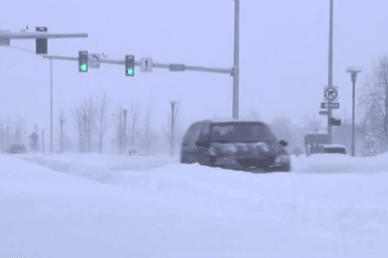Valdez, Alaska, turns to outside help to dig out from 10+ foot snow drifts
A car drives down a snow-line street in Anchorage, Alaska, last week. Much of southern Alaska has been buried in snow this year. (Photo from AP video.)
If you’re in the parts of the United States still looking for the first big snow of the season, Alaska would most likely be happy to send you some.
Valdez, Alaska, usually the snowiest places in the United States and often on top of the list globally, has received as much snow this winter though last weekend as it normally receives over the course of an entire season. So far, it’s received more than 322 inches, and the snow has been piled up high, with 10-foot drifts lining the roads, for example.
The problem, though, isn’t the streets, which have been thoroughly scraped to bare pavement, mostly. The problem is roofs. Already several have caved in and the local school district, for the first time in memory, had to cancel classes until laborers could clear the feet of snow piled on the roof.
Some 200 people have already been hired to remove snow from roofs and the city is now offering more than $20 an hour to entice more laborers to the area to pitch in.
Geo Beach, independent journalist and host of “Tougher In Alaska” on the History Channel, said there’s a lot of snow and simply “not enough elbow grease” to get the town back to a safe place.
“It just stacks up in Valdez,” he said. “The piles in town are reaching 30 feet. There’s so much opportunity in the private sector that twice in a week the city tried to boost the wage to get more people to help out.”
In Cordova, nearby, there’s plenty of labor but the entire town has run out of shovels. All supplies for Cordova have to come in by air or by boat; no roads connect Cordova with the rest of the Alaskan highway network.
“It’s Alaska, it’s tough snow. You can’t have a plastic, consumer-grade shovel to get it out of there,” Beach said. “There’s been a special shipment from the manufacturing facility in the lower 48.”
Beach said that the entire Kenai Peninsula(http://en.wikipedia.org/wiki/Kenai_Peninsula) where he lives, just south of Anchorage, was cut off by an avalanche that blocked the only road and railroad connecting the area to Anchorage.
“We’re back up now. It’s a very thin line that connects us here at the terminus of the North American highway system to the rest of civilization,” he said.
